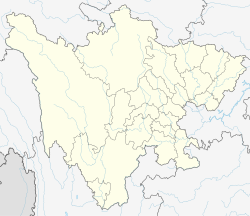Dzongsar Monastery
| Dzongsar Monastery | |
|---|---|
Dzongsar Jamyang Khyentse Rinpoche | |
| Location | |
| Location | Mehnshek, Dêgê County, Garzê Tibetan Autonomous Prefecture, Sichuan, China |
| Country | China |
| Geographic coordinates | 31°38′35″N 98°57′46″E / 31.64306°N 98.96278°E |
Dzongsar Monastery (Tibetan: རྫོང་གསར་དགོན།, Wylie: rdzong gsar dgon) is a Buddhist monastery in Dêgê County in the Garzê Tibetan Autonomous Prefecture of Sichuan, China, southeast of the town of Derge and east of Palpung Monastery. Historically it lay in the Kham region of Tibet. It was founded in 746, destroyed in 1958, and rebuilt in 1983.
The monastery belongs to the
History
Old monastery
Dzongsar Gonpa was founded in 746 AD by a

Before 1958, Dzongsar had between 300 and 500 permanent resident monks, but frequently had many more people who camped around the monastery in tents to meet with the lamas. All the temples were destroyed in 1958, but rebuilding began in 1983 under the guidance of Dr. Lodrö Puntsok.[1]
The monastery had twenty three temples, large and small, and many important sacred rooms.
New monastery

In 1983 the temples and institutions of the monastery were rebuilt but not in its full glory. It now only has six large and small temples.[2] However, 180 monk's residences have been rebuilt and today the main temples cover 48,200 square meters.[2] Today there are more than 200 monks residing at Dzongsar.[1] Dzongsar also runs a school teaching Tibetan traditions, and has an enrollment of about 60 children.[2] The monastery is also known for its incense and sells it commercially as Dzongsar Tibetan Incense Powder and Dzongsar Tibetan Incense Sticks.[1] The incense is made from precious, natural herbal materials from the highlands of Eastern Tibet and is said to have healing effects for the mind and soul, and have the ability to prevent infectious diseases.[1]
The current head lama of Dzongsar is the
References
- ^ a b c d e f "Dzongsar Tibetan Monastery". Essence of the Ages. Archived from the original on March 12, 2009. Retrieved December 6, 2009.
- ^ a b c d e f g h "History of Dzongsar Gonpa". China Tibet Information Center. June 13, 2005. Archived from the original on May 3, 2011. Retrieved December 6, 2009.
- ISBN 1-59030-025-4.



